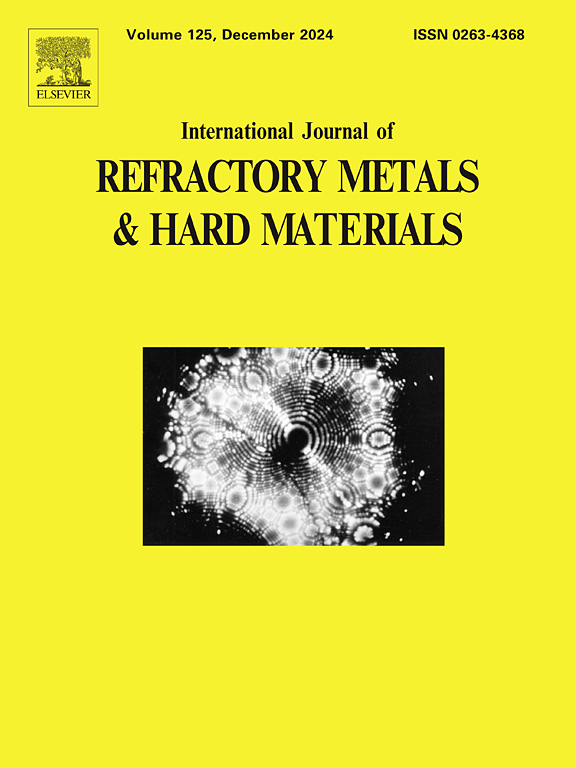SiC晶须与SiC颗粒协同增韧ZrB 2基陶瓷材料的显微组织、力学性能及摩擦性能
IF 4.2
2区 材料科学
Q2 MATERIALS SCIENCE, MULTIDISCIPLINARY
International Journal of Refractory Metals & Hard Materials
Pub Date : 2025-06-24
DOI:10.1016/j.ijrmhm.2025.107299
引用次数: 0
摘要
ZrB2是一种优异的超高温陶瓷,具有良好的热稳定性、高硬度和较强的抗热震性。然而,其相对较低的抗压痕断裂能力限制了其作为陶瓷刀具材料的应用。因此,本研究的重点是在ZrB2基体中添加SiCp和SiCw,以提高ZrB2基复合材料的切削刀具性能。采用热压烧结法制备了ZrB2-SiCp-SiCw复合材料。系统研究了SiCw/SiCp含量、烧结温度1750 ~ 1950℃、热压停留时间30 ~ 60 min对合金组织和力学性能的影响。通过对TC4钛合金的球盘磨损试验,评估了摩擦性能。此外,还对TC4进行了不同切削深度下的车削实验。结果表明,SiCw和SiCp的掺入显著提高了ZrB 2的力学性能和相对密度。添加20vol%SiCw-15vol%SiCp后,复合材料抗压痕断裂性能为6.48±0.07 MPa·m1/2,抗折强度为891±47 MPa,硬度为18.60±0.35 GPa,满足刀具应用要求。ZrB 2基陶瓷材料的动态摩擦系数稳定在0.55左右。当载荷从5 N增加到20 N时,磨损率从1.22 × 10−4 mm3/N·m增加到2.52 × 10−4 mm3/N·m。磨损机理是由磨损表面表征的磨料磨损和粘着磨损的结合。在高压-高温条件下加工TC4时,除了粘着磨损和磨粒磨损外,还观察到扩散和氧化磨损机制。本文章由计算机程序翻译,如有差异,请以英文原文为准。
Microstructure, mechanical properties and friction performance of SiC whisker and SiC particle synergistic toughening ZrB₂-based ceramic material for potential cutting tool
ZrB2 is a prominent ultra-high-temperature ceramic with good thermal stability, high hardness, and strong thermal shock resistance. However, its relatively low indentation fracture resistance limits its application as a ceramic cutting tool material. Therefore, the present study focuses on adding SiCp and SiCw to matrix ZrB2 to enhance the mechanical properties of ZrB2-based composites for cutting tool applications. ZrB2-SiCp-SiCw composites were fabricated by hot-pressing sintering. The effects of SiCw/SiCp content, sintering temperature 1750–1950 °C, and hot-pressing dwell time 30–60 min on the microstructure and mechanical properties were systematically investigated. The frictional performance was evaluated through ball-on-disk wear tests against TC4 titanium alloy. In addition, turning experiments of TC4 were conducted at different cutting depths. The results demonstrate that the incorporation of SiCw and SiCp significantly enhances both the mechanical properties and relative density of ZrB₂. With the addition of 20vol%SiCw-15vol%SiCp, the composite achieves a indentation fracture resistance of 6.48 ± 0.07 MPa·m1/2, a flexural strength of 891 ± 47 MPa, and a hardness of 18.60 ± 0.35 GPa, meeting the requirements for cutting tool applications. The ZrB₂-based ceramic material exhibited a stable dynamic friction coefficient of approximately 0.55. As the applied load was increased from 5 N to 20 N, the wear rate increased from 1.22 × 10−4 mm3/N·m to 2.52 × 10−4 mm3/N·m. The wear mechanisms are a combination of abrasive and adhesive wear by the worn surface characterization. During TC4 machining under high pressure-temperature conditions, diffusion and oxidative wear mechanisms were observed in addition to adhesive and abrasive wear.
求助全文
通过发布文献求助,成功后即可免费获取论文全文。
去求助
来源期刊
CiteScore
7.00
自引率
13.90%
发文量
236
审稿时长
35 days
期刊介绍:
The International Journal of Refractory Metals and Hard Materials (IJRMHM) publishes original research articles concerned with all aspects of refractory metals and hard materials. Refractory metals are defined as metals with melting points higher than 1800 °C. These are tungsten, molybdenum, chromium, tantalum, niobium, hafnium, and rhenium, as well as many compounds and alloys based thereupon. Hard materials that are included in the scope of this journal are defined as materials with hardness values higher than 1000 kg/mm2, primarily intended for applications as manufacturing tools or wear resistant components in mechanical systems. Thus they encompass carbides, nitrides and borides of metals, and related compounds. A special focus of this journal is put on the family of hardmetals, which is also known as cemented tungsten carbide, and cermets which are based on titanium carbide and carbonitrides with or without a metal binder. Ceramics and superhard materials including diamond and cubic boron nitride may also be accepted provided the subject material is presented as hard materials as defined above.

 求助内容:
求助内容: 应助结果提醒方式:
应助结果提醒方式:


